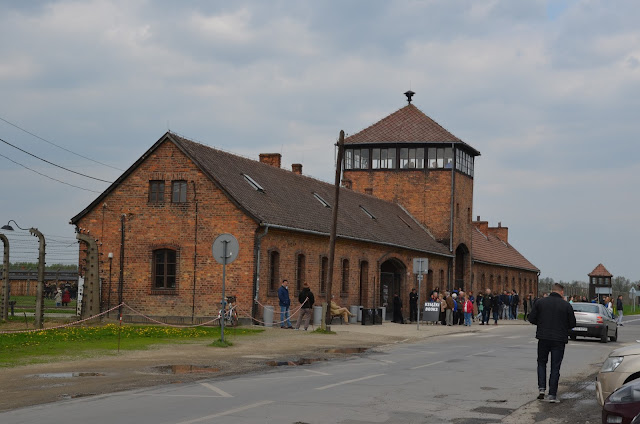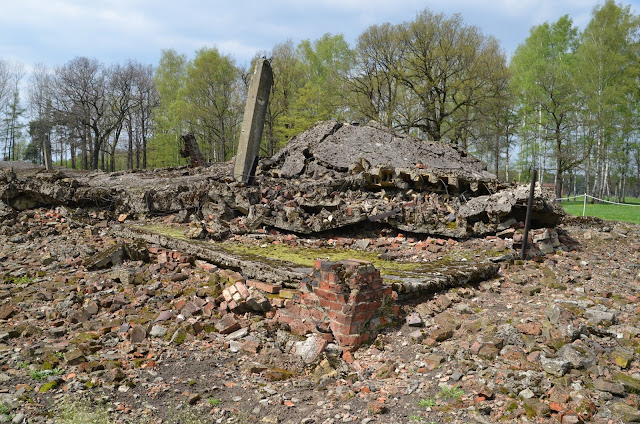Tuesday 19th April
It has taken me a long time to finish this Blog. It is a
difficult subject and while I’m not sure my words can do it justice, I think I
should at least try. Today we visited Auschwitz.
The bus from Krakow took around ninety minutes and cost a
few pounds each. The journey was unexpectedly scenic and surprisingly
beautiful. It struck me that while we weren’t following the train tracks,
seventy five years ago millions of people saw the same countryside, the same
towering trees and eventually, the same gate which reads “Arbeit Macht Frei” –
Work Brings Freedom.
Originally constructed to hold Polish political prisoners,
the first exterminations began in September 1941, and it wasn’t long before
Auschwitz-Birkenhau became an integral part of the Final Solution to the Jewish
Question. From 1942-1944 trains transported Jews from across Europe to the
camps and around 1.1 million prisoners died here. Around 90 percent were Jewish
and the remainder were Poles, Romani, Sinti, Soviet prisoners of war, Jehovah’s
Witnesses, homosexuals and thousands more from a diverse range of nationalities
and affiliations.
While Auschwitz is the most well known concentration camp, I
wasn’t prepared for the sheer size of the place. It’s so large that it’s
divided in to the main camp, also known Auschwitz I and Birkenhau which is
sometimes called Auschwitz II. The “main camp” was a pre-war Polish barracks
and was used for administrative purposes and now acts as a museum. In order to
visit the museum you have to book a time slot online where you can opt for a
self-guided or educator accompanied tour. After reading some reviews we decided
on a self-guided time slot and as we had left it so late to book, we went for
the only time available – 4pm entry.

In an attempt to make the most of the day we arrived at around noon and after collecting our tickets, made the fifteen minute bus journey to Birkenhau. Construction began in October 1941, and by March 1942, the first gas chamber was fully operational. I wasn’t sure what to expect but one of the first things you see are the train tracks leading directly in to the camp. From here we broke away from the groups and began exploring the camp. Our first stop was a bunk house where hundreds of people lived. It was strange to think that people had to live while surrounded by death but of course, Auschwitz-Birkenhau was also a work camp. I thought of the children who would have, for however brief a time, lived in the bunk houses and I wondered if, despite the exhaustion, the hunger and the fear, they played the way little children do.
We followed the fences, past the shells of former bunk
houses and to the crematoriums. In 1944, with the Red Army approaching, Hitler
ordered gassing operations to cease and in an attempt to hide their crimes, the
Nazis dismantled the crematoriums. While the twisted metal and broken bricks remain,
there are some new additions too. Commemorative stones are found next to places
of mass extermination and where the ashes of the murdered are located. These
commemorative stones are often adorned with candles brought from all over the
world and the stones bear the inscription “To the memory of the men, woman and children who fell victim to the Nazi
genocide. Here lie their ashes. May their souls rest in peace.”
The information plaques that are dotted around the site are
exceptional. They give a real insight in to what life was like at the camps and
some of them even feature photographs of the prisoners and the camp buildings. To
be standing in the exact spot where a photograph was taken seventy five years
ago, knowing that the landscape is the only thing that has remained the same,
is very surreal. I also found it difficult to reconcile the beauty of the place
with the horror of what happened here. At the beginning of the day when we got
off the bus I was unbelievably cold and I was prepared for the absence of life
but what I experienced was somewhat different. The sun came out and I noticed
that songbird were singing and frogs were hopping in and out of the shallow
ponds.

We ended up spending over three hours just walking around,
reading the signs and letting it all sink in. As we walked through the “laundry
building” we came across an exhibit which focused on some of the people who
ended up in Auschwitz-Birkenhau. As I read their stories I was struck by just
how ordinary these people were. Some were doctors and teachers; there was even
a family of chocolatiers who owned their own factory. Whole families ended up
here and more often than not, whole families died together. There were stories
of survivors and one such story, of a girl and her mother who were separated
upon entering the camp but who were reunited seventeen years after the war, really
stuck with me.
I think people are tempted to rush Birkenhau in favour of
Auschwitz I but I would really advise against this. There is something
undisturbed about Birkenhau. It is vast and bleak but at times, quite
beautiful. It is too important to rush and I really think time needs to be
dedicated to seeing where so many people lived and died. As we left, through a simple gate, I thought
of the vastness of the ever present fences and how all that separated these
people from the beautiful Polish countryside was a fence. How unnecessary and
preventable their deaths were.
From Birkenhau we made the short journey back to the main
camp and entered the museum. As it was late in the day the crowds had mostly
subsided and we were able to take our time at each exhibit. We did notice a few
groups who were accompanied by an educator being walked briskly past most of
the exhibits so we were glad we opted to go alone and take our time.
One of the first things we saw after passing though the
infamous gates was the original gas chamber. The small, dimly lit building was
full of significance. A man sang quietly in Hebrew and there wasn’t a sound
from the people who were taking the time to pay their respects.

 |
| The original Crematorium |
While all the buildings in the museum were special and
thought provoking, there are a few rooms dedicated to the possessions of the
prisoners that really struck a chord with me. They feature suitcases,
hairbrushes, prosthetic limbs, items of clothing, shoes and finally, canisters of
Zyklon B; the cyanide based pesticide used to kill over a million people at Auschwitz.
The soldiers who liberated the camp discovered the extent of its use when they
tested the hair of deceased prisoners. The hair, which was collected and eventually
sold for manufacturing purposes, contained traces of the chemical and further
incriminated the Nazis.
The sheer scale of the possessions highlights just how many people lost their lives in this sleepy Polish town. Thinking of the stories behind the items and the people who lost the very things they treasured enough to bring on the long journey from their homes across Europe, was completely heartbreaking. It is a feeling I will never forget and today was a day I hope I will always remember.

We left the museum shortly before closing time, when the
last of the visitors had left. We caught a late bus back to town and set about
finding somewhere for dinner. Finishing the evening in comfort, warmth, with
food, security and safety all guaranteed felt particularly special given the
day we had just had and I hope we will always feel this thankful. If you are
considering visiting Krakow and Auschwitz, I would absolutely encourage you to
do so. It might seem like morbid curiosity but I think that revisiting the past
is essential if we are to continue moving forward and towards a future built on
tolerance, understanding and the safeguarding of the most vulnerable in our
society.































































No comments:
Post a Comment